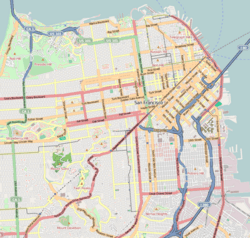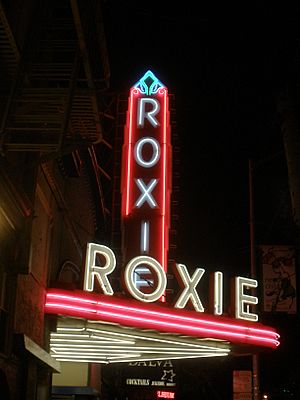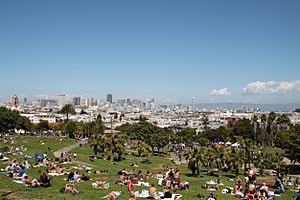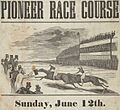Mission District, San Francisco facts for kids
The Mission District (in Spanish: Distrito de la Misión), often called the Mission (in Spanish: La Misión), is a lively neighborhood in San Francisco, California. It's one of the oldest parts of the city, and its name comes from Mission San Francisco de Asís, a historic building started in 1776 by the Spanish. The Mission has always been a very important center for San Francisco's Chicano and Mexican-American communities.
Quick facts for kids
Mission District
The Mission
|
|
|---|---|
| Country | |
| State | |
| City and county | |
| Area | |
| • Land | 1.481 sq mi (3.84 km2) |
| Population
(2019)
|
|
| • Total | 44,541 |
| • Density | 30,072/sq mi (11,611/km2) |
| Time zone | UTC−08:00 (Pacific) |
| • Summer (DST) | UTC−07:00 (PDT) |
| ZIP Codes |
94103, 94110
|
| Area codes | 415/628 |
Contents
Location and Weather
The Mission District is in the east-central part of San Francisco. It's bordered by U.S. Route 101 to the east. This highway separates the "Inner Mission" from Potrero Hill. To the northwest, Sanchez Street divides the Mission from Eureka Valley, which includes "the Castro". To the southwest, it borders Noe Valley.
The main street in the Mission District is Mission Street. South of the Mission, along Mission Street, are the Excelsior and Crocker-Amazon neighborhoods.
San Francisco's Microclimates
The Mission is often warmer and sunnier than other parts of San Francisco. This is because San Francisco has many different microclimates. This means that each neighborhood can have its own weather at any time. The Mission's location protects it from the fog and wind that come from the west. This is why you might notice the weather change as you walk from the foggier Noe Valley down into the sunnier Inner Mission.
Neighborhood Areas
The Mission District has four main areas:
- The northeast part, near Potrero Hill, is known for new tech companies, cool bars, and restaurants.
- The northwest part, along Dolores Street, has beautiful Victorian houses and the popular Dolores Park.
- The Valencia Street area (from 15th to 22nd Street) and the 24th Street area (called Calle 24) are popular for their restaurants, art galleries, and lively street scenes.
History of the Mission District
Native Peoples and Spanish Arrival
Long before the Spanish came, the Ohlone people lived in the area that is now the Mission District. The Yelamu Indians lived here for over 2,000 years. Spanish missionaries arrived in the late 1700s. They found the Yelamu living in two villages near Mission Creek.
On June 29, 1776, a Spanish priest named Father Francisco Palóu started Mission San Francisco de Asis here. The Mission was moved to its current spot in 1783. Native American workers were made to build the Mission, which was finished in 1791. This time marked a big change for the Yelamu culture. The number of Native Americans at Mission Dolores dropped a lot between 1833 and 1841.
San Francisco Grows South
After the Spanish, large farms called ranchos were owned by Spanish-Mexican families. These farms were separated from the town of Yerba Buena (which later became San Francisco) by a two-mile wooden road. This road was later paved and became Mission Street.
The land around the old mission church became a place for entertainment. There were animal competitions, horse racing, baseball, and duels. A famous resort called The Willows was located near Mission Creek. From 1865 to 1891, a large garden and zoo called Woodward's Gardens covered two city blocks.
After the California Gold Rush, San Francisco grew quickly. The Mission lands were developed into homes for working-class immigrants, mostly from Germany, Ireland, and Italy. It also became a place for factories and businesses.
Baseball History
As the city grew, the Mission District became home to California's first professional baseball stadium. It opened in 1868 and was called Recreation Grounds. It could hold 17,000 people. Later, the Mission District also had two other baseball stadiums: another Recreation Park and Seals Stadium. Both were used by local baseball teams like the Mission Reds and the San Francisco Seals.
Earthquake and Population Changes
In the late 1800s and early 1900s, many Irish and German immigrant workers moved to the Mission. Around 1900, it was not very crowded, with mostly white working-class families living in houses. After the 1906 San Francisco earthquake, many businesses and people who lost their homes moved to the Mission. This made Mission Street a very important shopping area.
In 1901, San Francisco stopped allowing burials in the city. This led to the creation of the nearby city of Colma. During the 1906 earthquake, one working fire hydrant, known as the 'Golden Fire Hydrant', helped save the Mission District from burning down.
In the 1940s to 1960s, many Mexican immigrants moved to the Mission. They had been displaced from another "Mexican Barrio" to build part of the Bay Bridge. This change made the Mission a strong Chicano/Latino neighborhood, which it still is today. Starting in the 1960s, more immigrants from Central America also moved in.
The 1970s to 1990s
In the 1960s and 1970s, some younger, middle-class people moved into the western Mission. A political movement started in the early 1970s when seven young Latino men, known as Los Siete de la Raza, were accused of a crime. The community supported them, seeing them as people who wanted to help Latinos get into college and improve the community. They helped create free bilingual services and a free breakfast program.
From the mid-1970s to the 1980s, Valencia Street was known for its many lesbian-friendly businesses and community spaces, like The Women's Building. In the late 1970s and early 1980s, the Valencia Street area also had a lively punk music scene with many bands and clubs. The neighborhood was even called "the New Bohemia" in 1995.
In the 1980s and 1990s, more immigrants and refugees came from Central America, South America, the Middle East, and other places. They were escaping wars and political problems. These new residents brought many Central American banks and businesses to Mission Street.
The 1990s to Today
From the late 1990s, especially during the dot-com boom, many young professionals moved into the Mission. This led to gentrification, which means that rent and housing prices went up. Many Latino middle-class families and artists moved to other parts of the city or to suburbs. Even with higher rents, many Mexican and Central American immigrants still live in the Mission. However, the Latino population has decreased.
The Mission remains a very important cultural center for San Francisco's Mexican/Chicano, Nicaraguan, Salvadoran, and Guatemalan communities. While Latino businesses are everywhere, the residents are not spread out evenly. Most Chicano/Latino residents live on the eastern and southern sides of the neighborhood. The western and northern parts are generally wealthier and have more white residents.
Since the 1990s, immigrants from Mexico's Yucatán region have created a Mayan-speaking community in the northern Mission. A park opened in 2017, called In Chan Kaajal Park, which has a Mayan-language name.
Landmarks and Features
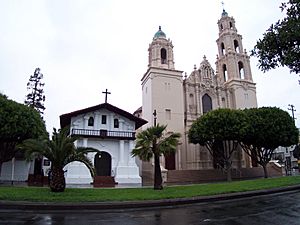
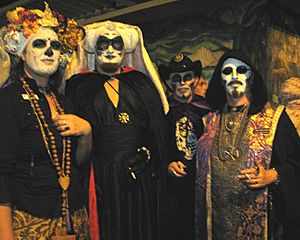
Mission Dolores is the historic mission that gave the neighborhood its name. It's located on Dolores Street and is the oldest building in the city. It still works as a museum and a California Historical Landmark. A newer church, built next to it in 1918, still has active services.
Dolores Park (Mission Dolores Park) is the biggest and one of the most popular parks in the neighborhood. It's near Mission Dolores. Across from the park is Mission High School, built in 1927.
The San Francisco Armory is a large, castle-like building at 14th and Mission. It was built as an armory for the U.S. Army and California National Guard.
Delicious Food
The Mission District is famous for its many restaurants. You can find dozens of taquerías (taco shops) that serve a special San Francisco style of Mexican food. The city is the original home of the Mission burrito. There are also many Salvadoran, Guatemalan, and Nicaraguan restaurants, plus lots of street food vendors. Some Mission restaurants have even won Michelin stars, which are awards for excellent food.
Vibrant Art Scene
The Mission is home to many Latino art and cultural groups. These groups started in the late 1960s and early 1970s to celebrate Latino art and traditions. The Mission Cultural Center for Latino Arts opened in 1976. The local bilingual newspaper El Tecolote started in 1970. The Mission's Galería de la Raza, founded by artists involved in the Chicano civil rights movement, is a nationally recognized art organization.
In late May, the city's annual Carnaval festival and parade takes place on Mission Street. It's inspired by the festival in Rio de Janeiro, but held in May for better weather. The first Carnaval in San Francisco was in 1978. Alejandro Murguía, a poet and writer, is known for his writings about the Mission District, where he has lived for a long time.
Because of its culture, once-lower housing costs, and many restaurants, the Mission attracts young people. It also has a strong independent arts community. Since the 1990s, it has been home to the Mission School art movement. Many art studios, galleries, and performance spaces are in the Mission. The Roxie Theater, the oldest movie theater in San Francisco, shows independent films and hosts film festivals.
Amazing Murals
Throughout the Mission, walls and fences are covered with colorful murals. These murals were started by the Chicano Art Mural Movement in the 1970s and are inspired by traditional Mexican paintings. Some of the most famous murals are in Balmy Alley and Clarion Alley. Many of these murals were painted or supported by the Precita Eyes muralist organization.
Lively Music Scene
Someone called my name
You know, I turned around to see
It was midnight in the Mission
and the bells were not for me
There's some satisfaction
in the San Francisco rain
No matter what comes down
the Mission always looks the same
Come again
Walking along in the Mission in the rain
The Mission is full of music. Mariachi bands play in restaurants, especially near Valencia and Mission streets. Carlos Santana, a famous musician, grew up in the Mission and graduated from Mission High School. He often returned to the neighborhood for concerts and documentaries.
The song "Mission in the Rain" by Robert Hunter and Jerry Garcia is about the neighborhood. Classical music can be heard at the San Francisco Community Music Center. The area is also home to Afrolicious and Dub Mission, a long-running reggae/dub music party. The Mission District also has a Hip-Hop and Rap music scene.
Talented Visual Artists
Many well-known artists have connections to the Mission District, including:
- Benjamin Bratt (born 1963), actor, film producer
- Peter Bratt (born 1962), film director, producer
- Craig Baldwin (born 1952), experimental filmmaker
- Chuy Campusano (1944–1997), Chicano muralist
- Rolando Castellón (born 1937), painter, author, art historian, and curator.
- Laurie Toby Edison (born 1942), photographer
- Rupert García (born 1941), artist and professor
- Ricardo Gouveia (born 1966), also known as "Rigo 23", painter, sculptor, and muralist
- David Ireland (1930–2009), sculptor, installation artist, co-founder of Capp Street Project
- Chris Johanson (born 1968), painter, muralist and street artist
- Margaret Kilgallen (1967–2001), painter, printmaker, and graffiti artist
- Lil Tuffy, poster art, serigraph printmaker and designer
- Carlos Loarca (born 1939), painter, muralist
- Yolanda López (1942–2021), painter, printmaker, educator, and film producer.
- Ralph Maradiaga (1934–1985), artist, curator, photographer, printmaker, teacher, and filmmaker
- Barry McGee (born 1966), also known as "Twist", painter and graffiti artist
- Ruby Neri (born 1970), painter, sculptor, and graffiti artist
- Sirron Norris, illustrator, and muralist
- Dan Plasma, graffiti artist, muralist
- Rex Ray (1956–2015), graphic designer and collage artist
- Peter Rodríguez (1926–2016), artist, curator, and museum director; founder of the Mexican Museum
- Spain Rodriguez (1940–2002), underground cartoonist.
- Michael V. Rios, painter, designer, and muralist
- Pico Sanchez, painter, printmaker
- Adam Savage (born 1967), television personality, model maker, designer, fabricator
- Dori Seda (1951–1988), cartoonist, painter
- Xavier Viramontes (born 1947), printmaker
- Scott Williams (born 1956) stencil artist, muralist
- Megan Wilson, conceptual, installation, and muralist
- René Yañez (1942–2018), painter, assemblage artist, performance artist, curator and community activist.
Art Organizations
The Mission is home to many art organizations, including:
- Acción Latina
- Art Explosion Studios
- Artists' Television Access (ATA)
- Brava Theater
- City Art Collective Gallery
- Creativity Explored
- Eth-Noh-Tec, Kinetic Story Theater Eth-Noh-Tec (storytelling kinetic theater)
- Gray Area
- Kadist
- Mission Cultural Center for Latino Arts
- Project Artaud
- Root Division, from 2002 until 2015
- Ruth's Table
- San Francisco Community Music Center
- Savernack Street
- Southern Exposure
- Theatre of Yugen at NOHspace
- The Lab
- The Marsh
- 1890 Bryant St Studios
- 500 Capp Street
Festivals and Parades
The Mission District hosts many fun festivals and parades throughout the year:
- Carnaval – The biggest event each year is the Mission's Carnaval celebration, held on Memorial Day weekend.
- 24th Street Fair – In March, a street fair is held along 24th Street.
- San Francisco Food Fair – Every September, food trucks and vendors sell food to thousands of people along Folsom Street.
- Cesar Chavez Holiday Parade – In April, there's a parade and celebration on 24th Street to honor Cesar Chavez.
- Transgender and Dyke Marches – In late June, there are big celebrations at Dolores Park, followed by marches along 18th and Valencia Streets.
- Sunday Streets – Twice a year, Valencia, Harrison, and 24th Streets are closed to cars. People can walk and bike freely as part of the Sunday Streets program.
- Day of the Dead – Every November 2, there's a memorial procession and celebration of the dead (Dia de los Muertos) on Harrison and 24th Street.
- First Friday – On the first Friday evening of each month, there's a food and art event with lowrider cars and samba dancers along 24th Street.
- Open Studios – In early October, the ArtSpan group organizes a show where Mission District artists open their studios to the public.
- Hunky Jesus Contest – This fun event was held annually on Easter Sunday in Dolores Park until 2014, when it moved to Golden Gate Park.
- Rock Make Street Festival – This music and arts festival takes place in September on Treat and 18th Streets.
- LitCrawl – In October, as part of a literature festival, hundreds of book and poetry readings are held in bars and bookstores throughout the Mission.
- Party on Block 18 – This summer street party helps raise money for The Woman's Building and other local groups.
- Clarion Alley Block Party – This block party takes place every October on the Clarion mural alley.
- Remembering 1906 – Every year, people gather to repaint the "Golden Fire Hydrant" at Church and 20th Streets. This hydrant was the only one working after the 1906 earthquake and helped stop the fires.
Local Media
The Mission District has three free bilingual newspapers: El Tecolote (published every two weeks), Mission Local (mostly online with a printed paper twice a year), and El Reportero (a weekly newspaper with an online site).
Public Transportation
The neighborhood is served by the BART train system, with stations on Mission Street at 16th Street and 24th Street. It also has many Muni bus lines and the J Church Muni Metro line.
Neighborhood Changes
The Mission District has historically been a busy place for the Chicano and Latino community, especially around the 16th Street BART Plaza. This area is like a public market with live music and food trucks. It's also a key spot for public transportation, used by many working-class residents. Most people living in the Mission District are from minority groups and low-income families.
However, because of the Dot-Com Boom in the 1990s and the growth of technology companies, many tech offices moved to places like Silicon Valley. The Mission has felt the effects of these changes. The high demand for housing and limited supply have caused rents to go up, leading to gentrification. This has caused some families and small businesses to be forced out of the neighborhood. Many residents have protested these changes, forming groups like the "Plaza 16 Coalition." They work to support affordable housing and oppose new luxury developments.
Education
The San Francisco Unified School District runs public schools in the Mission District. These include:
- John O'Connell High School
- Buena Vista Horace Mann K-8 Community School
- Bryant Elementary School
- César Chávez Elementary School
- Leonard R. Flynn Elementary School
- Marshall Elementary School
- George R. Moscone Elementary School (which had 350 students in 2020)
- Zaida T. Rodriguez Early Education School
- Hilltop Special Service Center (a special school for grades 7–12)
The Roman Catholic Archdiocese of San Francisco operates St. Peter's Catholic School, which opened in 1878. In the past, its students were mostly Irish or Italian American. By 2014, 95% of the students were Latino, and about two-thirds were from families with lower incomes. The school's enrollment dropped from around 600 to 300 by 2014 due to rising costs in the neighborhood.
Images for kids
-
Pioneer Race Course in 1853, located just south of 24th and Shotwell St.
-
The Women's Building. Street murals and paintings of Latin American culture by local artists are a common feature and attraction.
See also
 In Spanish: Distrito de la Misión (San Francisco) para niños
In Spanish: Distrito de la Misión (San Francisco) para niños


